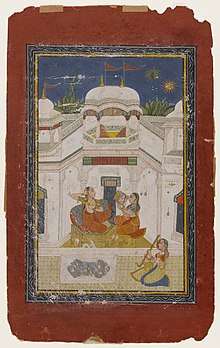Bilaval
 | |
| Thaat | Bilaval |
|---|---|
| Type | Sampurna |
| Arohana | Sa Re Ga,Ma Pa, Dha Ni Sa' |
| Avarohana | Sa' Ni Dha, Pa, Ma Ga,Re Sa |
| Pakad |
|
| Vadi | Dha |
| Samavadi | Ga |
| Synonym | Bilawal |
| Equivalent | |
| Hindustani classical music |
|---|
| Concepts |
| Genres |
| Thaats |
Bilaval or Bilawal (IAST: Bilāval) is a raga and the basis for the eponymous thaat (musical mode) in Hindustani classical music. Raga Bilaval is named after Veraval, Gujarat.[1] The Indian national anthem Jana gana mana is sung in Bilaval.
Bilaval had become the basic scale for North Indian music by the early part of the 19th century. Its tonal relationships are comparable to the Western music C major scale. Bilaval appears in the Ragamala as a ragini of Bhairav, but today it is the head of the Bilaval thaat. The Ragamala names Bilaval as a putra (son) of Bhairav, but no relation between these two ragas is made today. Bilaval is a morning raga to be sung with a feeling of deep devotion and repose, often performed during the hot months. The Bilaval thaat is equivalent to the Carnatic melakarta raga, Dheerasankarabharanam, as well as the Western Ionian mode (major scale) and contains the notes S R G M P D N S'. The pitches of Bilaval thaat are all shuddha, or natural. Flat (komal) or sharp (tivra) of pitches always occurs with reference to the interval pattern in Bilaval thaat.
Bilaval is one of the ragas that appears in the Sikh tradition from northern India, and is part of the Sikh holy scripture (Granth), the Sri Guru Granth Sahib. Every raga has a strict set of rules which govern the number of notes that can be used; which notes can be used; and their interplay that has to be adhered to for the composition of a tune. In the Sri Guru Granth Sahib, there are a total of 31 raga compositions. Bilaval is the sixteenth raga to appear in the series. The composition in this raga appear on a total of 64 pages from page numbers 795 to 859.
Aroha and Avaroha
Arohana: Sa Re Ga,Ma Pa, Dha Ni Sa'
Avrohana: Sa' Ni Dha, Pa, Ma Ga,Re Sa
Vadi and Samavadi
Vadi: Dha
Samavadi: Ga
Pakad or Chalan
Ga Re, Ga Ma Dha Pa, Ma Ga, Ma Re Sa
Ga Re Ga Pa, Ni Dha Ni Sa'
Sa' Ni Dha Pa Ga Ma Re Sa
Samay (Time)
Morning: First prahara of the day
Notes
- ↑ Delvoye, Françoise (2013). New Developments in Asian Studies. Routledge. p. 344. ISBN 9781136174704.
References
- Bor, Joep (ed). Rao, Suvarnalata; der Meer, Wim van; Harvey, Jane (co-authors) The Raga Guide: A Survey of 74 Hindustani Ragas. Zenith Media, London: 1999.
